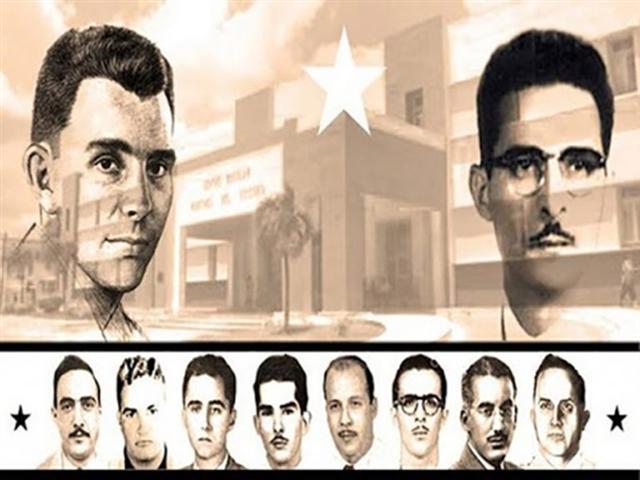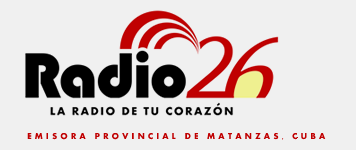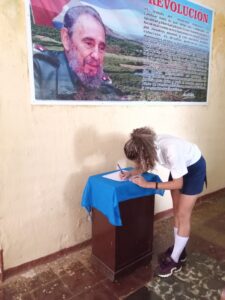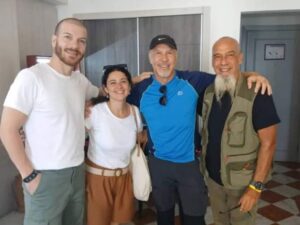An Ode to the Cuban Revolutionary Martyrs.

The date has become a glorious day to praise the long list of heroes who gave their lives to the national independence cause and, among them, the fighters Raúl Pujol Arencibia and Frank País García, who fell on the same date but in 1957 and to whom we pay tribute today.

On July 26th, 1959, in the heat of the sixth anniversary of the assault on the Moncada and Carlos Manuel de Céspedes Barracks, the then Minister of Agriculture, Pedro Miret Prieto, proposed to the Council of Ministers the designation of July 30th as the Day of the Martyrs of the Cuban Revolution.
Since then, the penultimate day of the seventh month has become a glorious day to praise the long list of heroes who gave their lives to the cause of national independence and, among them, the fighters Raúl Pujol Arencibia and Frank País García, who fell on the same date but in 1957 and to whom we pay tribute today. Raúl Pujol: justice and generosity until the end.
The ranks of the 26th of July Movement had in Raul Pujol Arencibia one of its most fervent members, whose sense of justice, patriotism and courage made him repudiate the growing atrocities of the Batista tyranny and act to the last consequences to overthrow it. Born on December 2nd, 1918 in the central Palma de Palma Soriano, formerly Oriente province, Pujol Arencibia began his academic life in Santiago de Cuba and, from an early age, worked as a messenger and apprentice hardware store clerk, while he was a Mason and found in fishing one of his most adored passions.
In his revolutionary journey, his support in terms of clothes and money to several of the survivors of the Moncadista struggle and his presence in the clandestine activities that, as resistance to Batista’s forces, materialized in the area, as well as his leading role in the organization of the Santiago Civic Resistance and the fact of lending his home for multiple meetings of the aforementioned 26th of July Movement, to which he proudly belonged, stand out.
Likewise, once the II Eastern Front was formed, he assumed the responsibility of guaranteeing the necessary equipment and supplies for the rebel forces, also taking his hardware store as the center of operations for the revolutionary flank.
But the obstinate eagerness of the Batista regime’s hired assassins to curtail his insurrectionary actions was consummated on the unfortunate July 30th, 1957 when, after a betrayal, he was surprised together with his companion Frank País García and both were deprived of their existence.
Frank País: Fighting for the homeland from the underground
On July 30th, 1957, the largest of the Antilles lost another of its most courageous sons, a young man who, with little more than two decades of life, consolidated his being to the Cuban revolutionary cause until he became one of its most emblematic architects and a stone in the shoe for the Batista hegemony.
Born on December 7th, 1934, this Santiago native named Frank Isaac País García inherited from his parents the purity and rectitude of his principles and obtained meritorious academic results, besides developing a growing passion for the arts and literature, even learning to play the piano and the organ.
His evident student leadership allowed him to lead the Students’ Association of the Normal School of Santiago de Cuba and once he graduated as a teacher, he founded a school for the improvement of workers and organized the so-called Revolutionary Block of Normal Students.
Between 1953 and 1954, he was the secretary of the FEU Oriental in the School of Pedagogy and president of its agrarian bureau, while he joined the committees for agrarian reform and the struggle against the Via-Cuba canal, an imperialist project sympathetic to the fragmentation of the island into two parts and, despite the military setback of July 26th, he continued advocating the armed struggle as an alternative to undermine the tyranny from Acción Liberadora Nacional, a structure he created in 1954.
This organization was succeeded by Acción Revolucionaria Oriental, which gradually added workers, peasants and other followers from all over the island, until it was reborn as an important rebel front under the label Acción Nacional Revolucionaria.
Later, he became the head of Action and Sabotage of the National Directorate of the 26th of July Movement, organized the armed uprising of November 30th in his hometown in support of the landing of the expeditionaries of the Granma yacht and, in February 1957, before the supposed death of Fidel Castro, he joined other fighters to lead the journalist Herbert Matthews, of The New York Times, to the historic leader and deny the rumors.
There was never lack of detractors of his socio-political and insurrectionist actions and, after a fierce hunt, on July 30th he was caught together with the aforementioned Raúl Pujol Arencibia in the Callejón del Muro and, once the perpetrators noticed that he was the main architect of the clandestine struggle, the deadly repression was immediate.
A month before, he had lost his brother Josué for similar reasons and, as then, the commotion was not long in coming. The nation knew it had lost one of its most glorious defenders, the offspring of Francisco País Pesqueira and Rosario García Calviño, whose existence, although ephemeral, made him «the most valuable, the most useful, the most extraordinary of our fighters», as the Historic Leader would later qualify him.
A glorious day for Cuba
Ever since October 10th, 1868, when the cry of Carlos Manuel de Céspedes became the starting point for the largest of the Antilles to seek its emancipation, an endless list of brave men and women, with courage, a sense of justice and full patriotism, has shone in the firmament of the Cuban Revolution.
It took a little more than nine decades for the dream of the Father of the Homeland to find in Fidel Castro its materialization on January 1, 1959 and for Cuba to grow with every challenge that choosing the path of socialism implied for its people, to the chagrin of the imperialist voracity in its eagerness to control everything that confronts it.
The ideals of José Martí, the military intransigence of Agramonte, Maceo, Gómez, the youthful vigor of Guiteras, Villena, de la Torriente, Mella, the leadership of Fidel, Raúl, Almeida… It would be impossible to enumerate in such limited lines the invaluable struggle of so many fallen brothers, children, youth, adults, elderly, Cubans or not, who will never be forgotten, because their mark survives, reverberates, ennobles.
Marked by the bloody struggle and the excessive sacrifice of those who honourably fought for independence, Martyrs’ Day is therefore an opportune occasion to remember these mambises of yesterday, today and tomorrow whose imprint we will carry forever, because, as our Apostle said «as sacred remains the breast where a hero throbbed: life is like a perennial canticle: he is loved in glory, and in error he would be loved: he is protected and surrounded by the filial people, with the most tender and firm love, which is that of gratitude».
Written by Yadiel Barbón Salgado.




